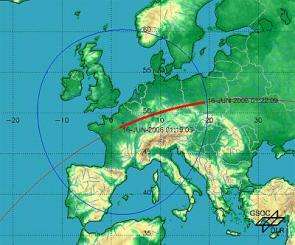Ground track of ISS pass over Europe on 16 June 2006. The red line shows the path of the Station. The thick red line shows when the Station will be visible to the observer. The visible pass starts at 01:09 CEST and ends at 01:22 CEST. Credits: Heavens Above/DLR-GSOC Planning Technology Team
Conditions in Europe are set to be ideal for perfect views of the International Space Station (ISS) as it passes overhead up to four times a night this coming weekend.
Provided you know in which direction to look, spotting the ISS with the naked eye is not as difficult as it might seem. Although the ISS travels at a speed of 7.7 km per second, it is just 400 km above our heads – and thanks to its large solar panels it is one of the brightest objects in the night sky, making it fairly easy to spot from when it rises above the horizon in a westerly direction, until it sets towards the East.
The ISS passes over most points on Earth every day, but cannot always be seen. Normally the best time for ISS-gazing is just before dawn or just after sunset, when the observer is in the dark but the ISS is in the Sun. But for two short periods in June and December each year, the ISS doesn't pass through Earth's shadow at all, and its passes are visible all through the night if the sky is clear.
For most locations in Europe the period of frequent visibility is between 17-21 June – although in some places the ISS is already making a regular appearance throughout the night.
Go to http://www.esa.int/seeiss to find out the best viewing times from where you live.
Source: ESA
























